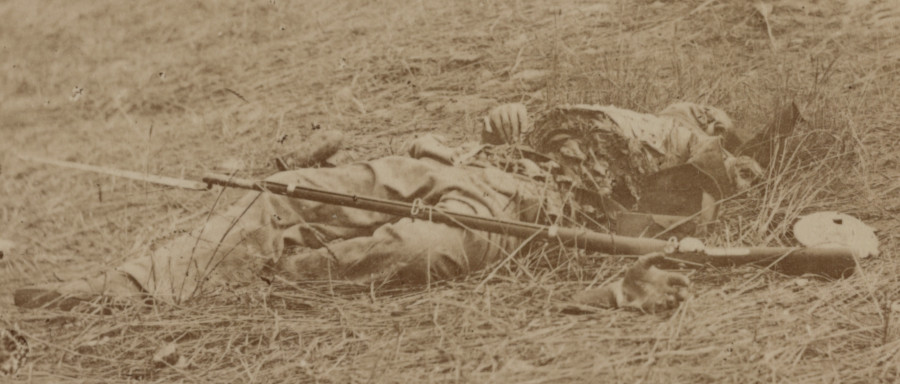
collecting bodies for burial was a gruesome task
Source: Library of Congress, The horrors of war

collecting bodies for burial was a gruesome task
Source: Library of Congress, The horrors of war
Dead bodies of soldiers were typically buried quickly on the battlefield. Confederate or Union forces that ended up with possession of a site would direct units of soldiers, or hire enslaved people or local laborers, to dig graves. If troops moved too fast to perform that duty, local residents had to bury the dead on their own initiative if they wanted to replant or harvest fields.
At Spotsylvania Battlefield, the Union Army occupied the ground after May 13. When the soldiers left on May 21, there were many bodies of soldiers from both sides still lying on the ground where they died, turning black and bloating in the sun. One soldier wrote:1
Burial was an unpleasant challenge. In the hot summer, bodies and dismembered body parts bloated quickly. Dead people and especially dead horses created a stench across the area. Individual graves were shallow, not dug six feet deep. Dirt excavated from a one-foot or two-foot hole would be piled on the side. After a body was shoved into the hole, the dirt would be piled on top and the gravedigger moved on to the next dead soldier lying on the ground. Such graves provided little protection from wild animals seeking a quick meal.
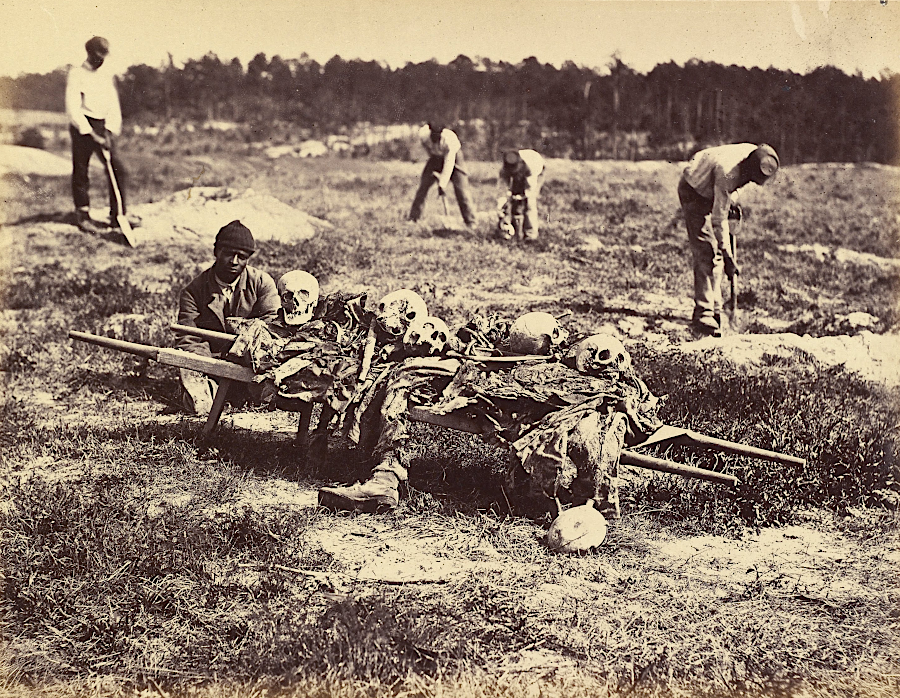
the remains of soldiers killed at Cold Harbor in 1864 were excavated and reburied in 1866
Source: Google Arts and Culture (by John Reekie, 1866)
Where the ground was hard and dry, it was easier to pick up the remains, put them on a cart, and move them to a ravine. Mass graves could be dug by excavating a series of adjacent holes, using the dirt from a new hole to cover a body just placed in the ground. On occasion, particularly if burials were done by soldiers from a regiment who had an appreciation of the dead, wooden markers with names were erected at the graves.
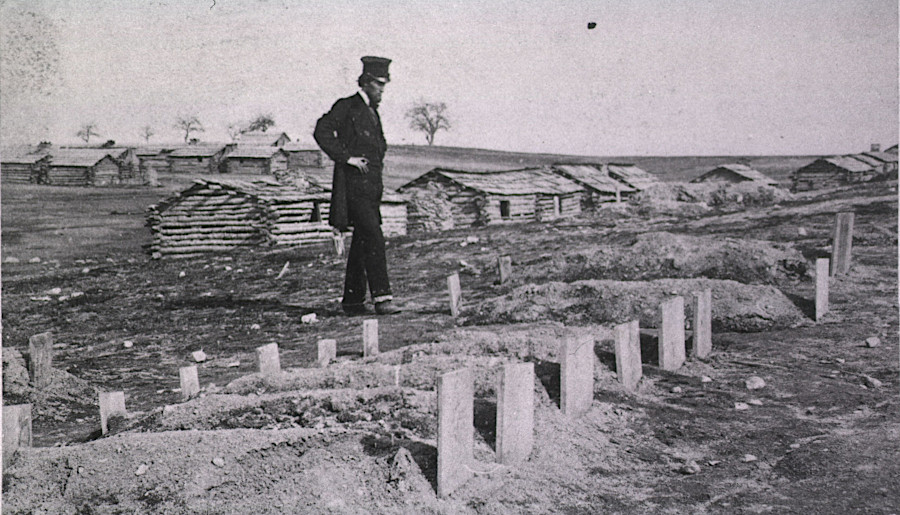
if any markers were placed at initial graves, they were typically temporary and made of wood
Source: National Library of Medicine, Soldiers' graves at Bull Run
Confederate soldiers who occupied the battleground in the months after First Manassas did not honor the buried Yankees. Soldiers hunted for relics, including bones as well as buttons. A Massachusetts resident came to Manassas to find the body of his brother. In the process, he discovered a skeleton whose shinbone had been sawed - apparently in order to make finger-rings.
Desecration of the "enemy" bodies also occurred. The body of Major Sullivan Ballou was dug up, beheaded and finally burned after the Union Army retreated from the Battle of First Manassas.2
Farmers normally plowed around known mass graves, but in the years after battles it was common to exhume isolated burials. Post-Appomattox, the Federal government made a concerted effort to excavate burials of Union soldiers and move remains to new national cemeteries.
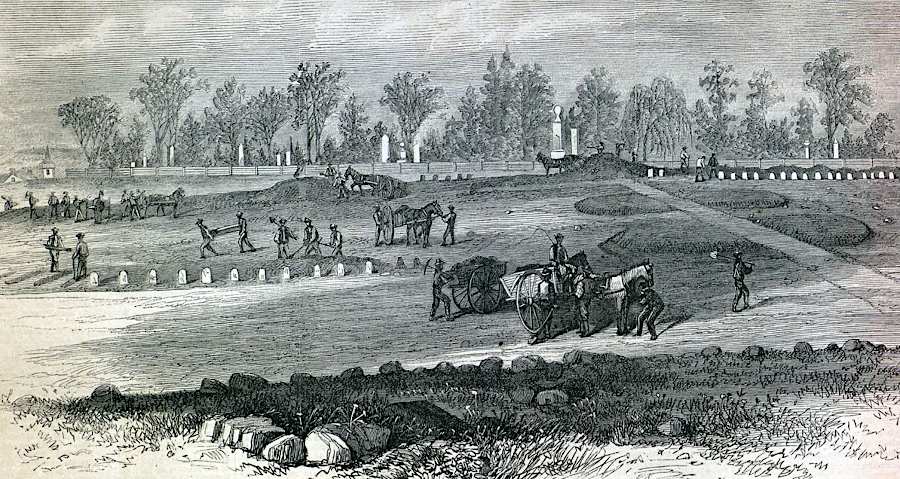
starting in 1866, bones of over 2,500 Confederate soldiers were reburied at Stonewall Cemetery in Winchester
Source: Winchester Tales, Facebook post (March 22, 2024)
The remains of many Confederate soldiers were also exhumed and moved to formal cemetery sites. Skeletons still lying on the surface at some old battlefields were finally collected and buried.
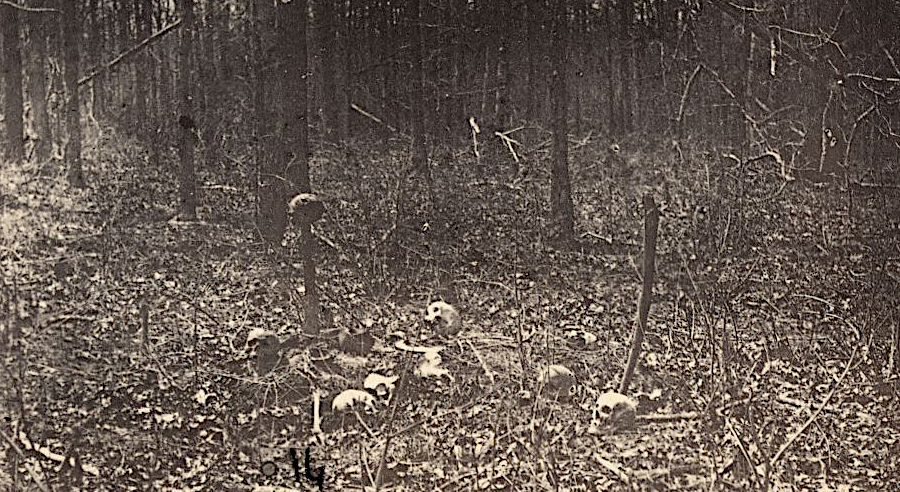
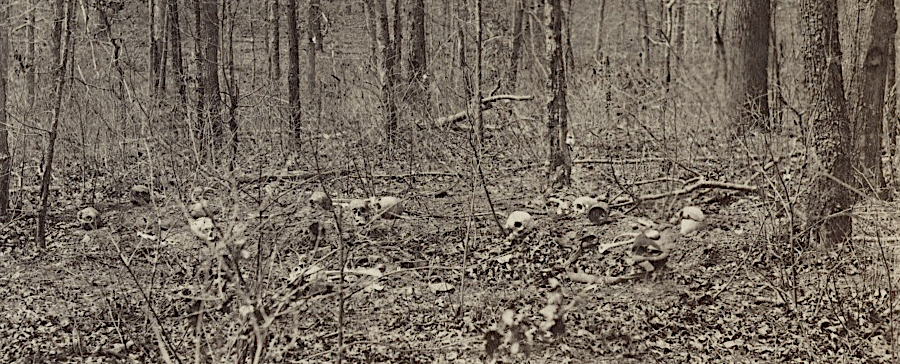
some soldiers were not buried until after the Civil War had ended
Source: Library of Congress, Skulls and bones of unburied soldiers on south side of Plank Road in 1865; Skulls and bones of unburied soldiers on south side of Plank Road in 1865
Union soldiers who died in Confederate prisons and hospitals were buried in various places across Virginia between 1862-65. In Richmond, around 500 were buried in the Shockoe Hill Burying Ground. That was a sign of disrespect; the cemetery had been created for burial of free blacks and enslaved people to replace the earlier "Burial Ground for Negroes." Confederate soldiers were buried in the walled-off section of the Shockoe Hill Cemetery that was reserved for whites.
Many of the buried Union soldiers in those different graveyards could not be identified by name. In 1866, General Montgomery Meigs created a monument in what is now Arlington National Cemetery for reburial of unidentified Union dead excavated from Virginia battlefields. Those in the in the Shockoe Hill Burying Ground were trabnsfered to the Richmond National Cemetery.
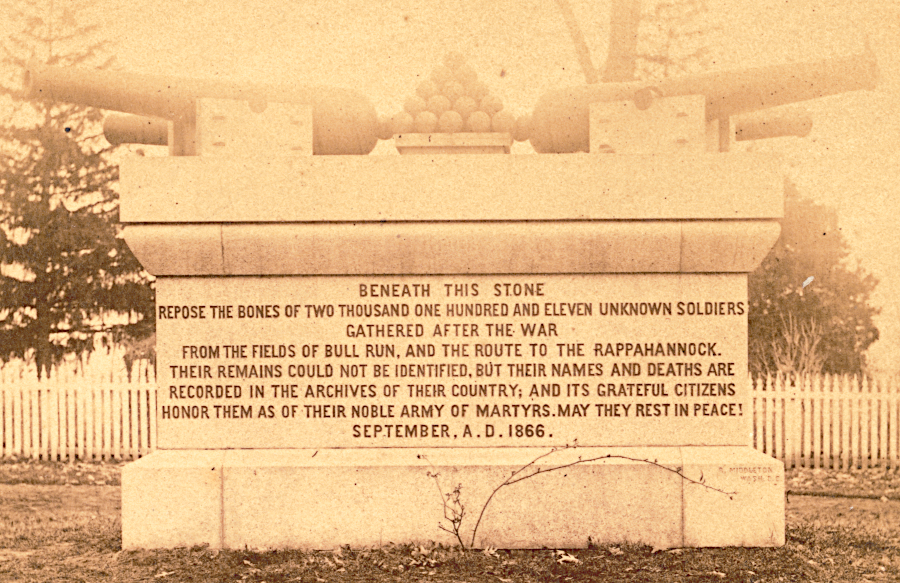
unidentified Union soldiers were reburied at Arlington Cemetery in 1866
Source: Library of Congress, Civil War Unknowns monument, designed by Montgomery Meigs and dedicated in 1866, at Arlington Cemetery
The National Park Service lists 18 Federal cemeteries in Virginia specifically created to bury Civil War veterans from the Union Army. No other state has more such cemeteries. The Veterans Administration manages all except four. The Department of the Army manages Arlington National Cemetery. The National Park Service manages civil War cemeteries in Fredericksburg, Poplar Grove, and Yorktown:3
Alexandria National Cemetery, Alexandria
Arlington National Cemetery, Arlington
Ball's Bluff National Cemetery, Leesburg
City Point National Cemetery, Hopewell
Cold Harbor National Cemetery, Mechanicsville
Culpeper National Cemetery, Culpeper
Danville National Cemetery, Danville
Fort Harrison National Cemetery, Richmond
Fredericksburg National Cemetery, Fredericksburg
Glendale National Cemetery, Richmond
Hampton National Cemetery, Hampton
Hampton Veterans Affairs Medical Center (VAMC) National Cemetery, Hampton
Poplar Grove National Cemetery, Petersburg
Richmond National Cemetery, Richmond
Seven Pines National Cemetery, Sandston
Staunton National Cemetery, Staunton
Winchester National Cemetery, Winchester
Yorktown National Cemetery, Yorktown
New burial grounds for Confederate soldiers were created after the Civil War without Federal funds, though some Confederate soldiers ended up in national cemeteries.
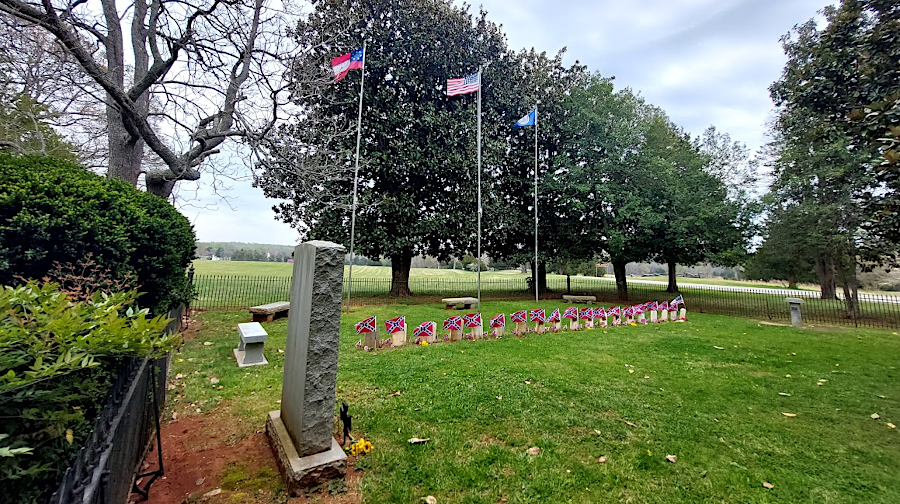
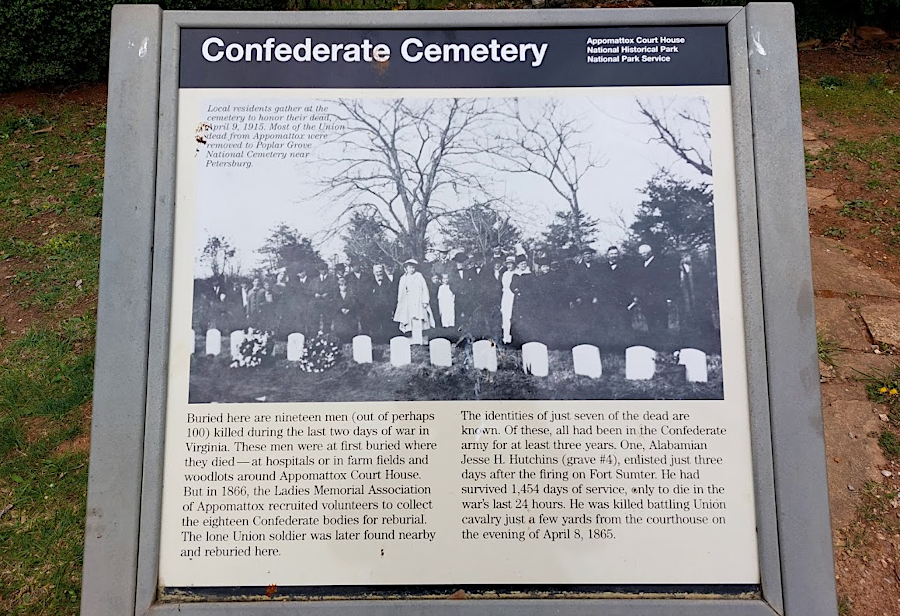
Confederate soldiers were exhumed and reburied at Appomattox Court House
There are many other cemeteries across the state in which soldiers were buried. Where soldiers camped, many died of disease and were buried nearby. Similarly, there are cemeteries near hospitals for those who died of diseases or wounds. Amputated limbs and even whole bodies were placed in wound pits next to hospitals, such as at Manassas National Battlefield Park.
Source: Exploring History Together, A Tour of the Alabama 10th Regiment Civil War Cemetery, Bristow Virginia
Hollywood Cemetery in Richmond highlights that it is the final resting place for Confederate soldiers, officers, and even Jefferson Davis, the only president of the Confederate States of America. As in Arlington National Cemetery, there is a large monument in Hollywood Cemetery to honor the unknown who were re-interred there.
Oakwood Cemetery, the city's public burial ground on the eastern side of Richmond, was designed with the same rural style to mimic the private Hollywood Cemetery. It opened in 1854, with the first internments in the isolated section designated "for the burial of colored persons." About 16,000 Confederate soldiers were buried there, with many bodies coming from Chimborazo Hospital on Church Hill. A memorial obelisk was installed in 1871.
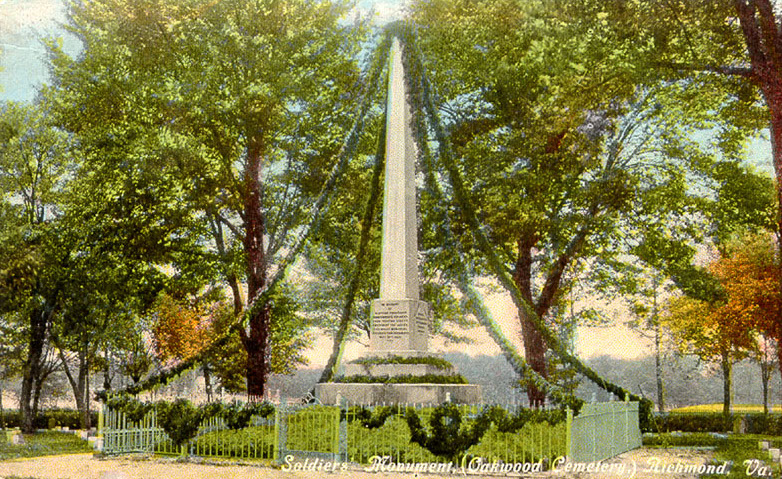
an obelisk honoring Confederate soldiers was erected in Oakwood Cemetery in 1871
Source: Virginia Commonwealth University (VCU), Soldiers' Monument (Oakwood Cemetery,) Richmond, Va.
The 1857 Manchester Municipal Cemetery received bodies from military hospitals south of the James River during the Civil War. At the time,, Manchester was a separate city from Richmond. Taking the remains to the private Hollywood Cemetery or the public Oakwood Cemetery in Richmond would have required making arrangements with a different jurisdiction and paying a toll to cross the Mayo Bridge.
The city of Richmond removed Confederate memorials from Monument Avenue and other places starting in 2020, a process that was completed in 2022 when the A. P. Hill monument on Laburnum Avenue was taken down. However, in 2024 the city upgraded the area around a marker placed at the Manchester cemetery in 1939 by the United Daughters of the Confederacy.
The marker at 2313 Wise Street honored 100 Confederate soldiers from South Carolina who had died in the South Carolina Hospital and General Hospital #28 in 1861-62. The city had built a natural gas booster substation there in 1931, and the memorial may have been installed after skeletons were discovered during construction.
Richmond built a chain link fence surrounding the booster substation and the unmarked cemetery. After a descendant of a South Carolina soldier asked for the city to enhance public access, the fence was modified to place the monument outside of it. State law requires owners of cemeteries to provide reasonable access to the families of people buried there. A modern bench was added to view the monument, but later removed.
After the city's recent $16,000 investment was questioned, Richmond officials commissioned a study to define the extent of the graveyard on the 1.2 acre parcel. There were no gravestones or markers for any individual graves, but ground penetrating radar identified 742 potential unmarked graves in the cemetery.
Richmond officials received complaints that the memorial was a Confederate monument that should be removed. They chose instead to treat it as a cemetery memorial, unlike those removed in 2020 from Monument Avenue because they honored Confederate leaders.4
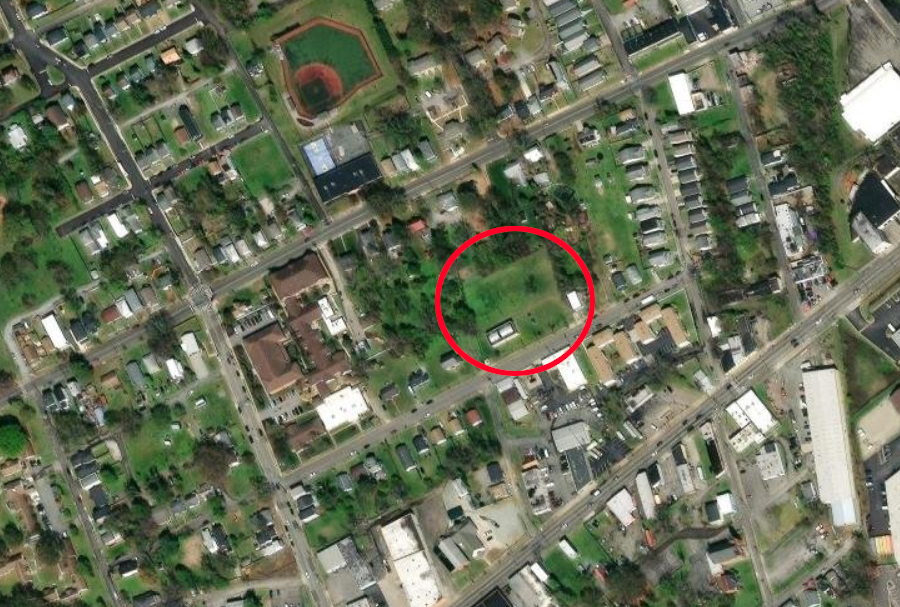
site of Manchester Municipal Cemetery in Richmond (natural gas booster station in southeast corner)
Source: ESRI, ArcGIS Online
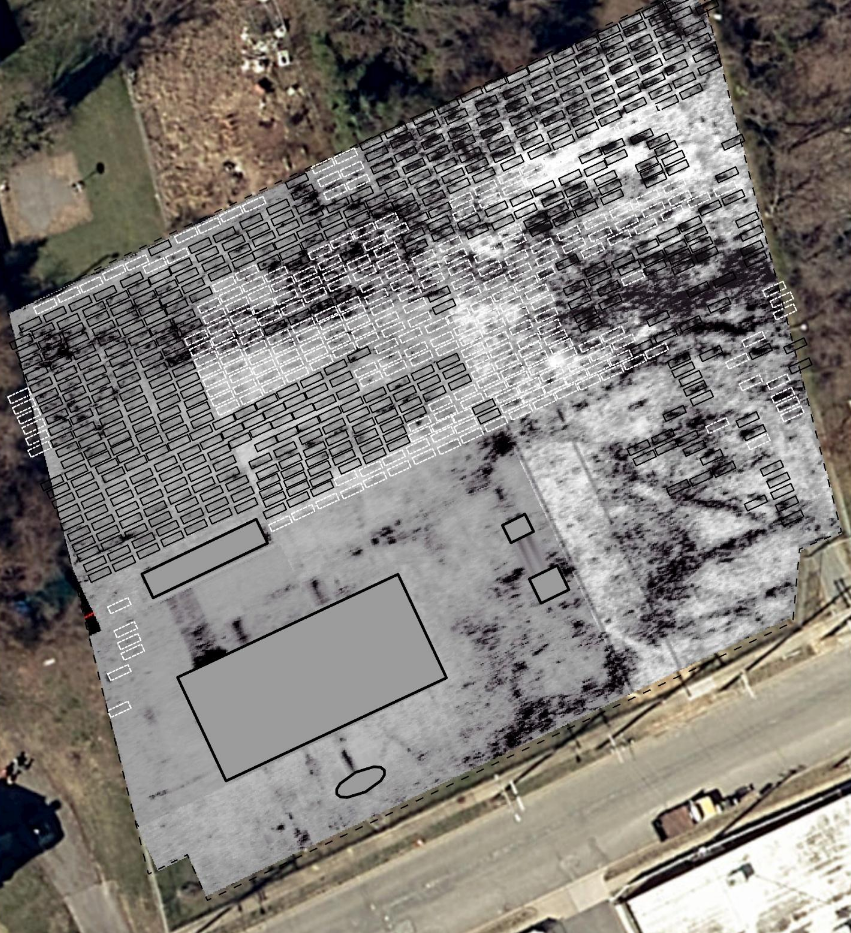
in 2025 ground penetrating radar identified 472 probable (black outline) graves and 270 possible (white outline) graves at the Manchester Municipal Cemetery
Source: Richmond Department of Public Utilities, A Ground Penetrating Radar Survey of the 1857 Manchester Municipal Cemetery Richmond, Virginia (p.51)
Many soldiers lie in family or community graveyards, such as John Singleton Mosby in Warrenton Cemetery. Others who died as the result of fighting were hastily buried on the spot, or not even buried at all.
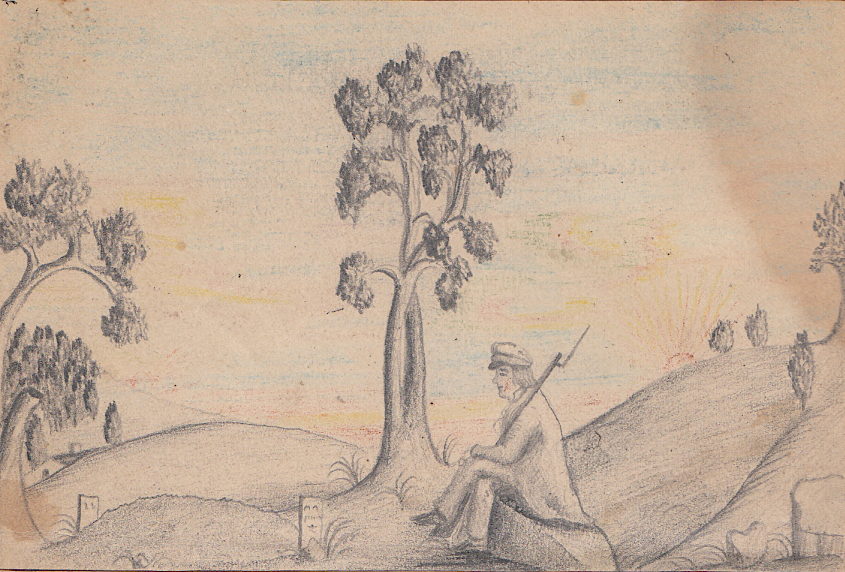
many soldiers were buried in family plots, or at camps where they died from disease or wounds
Source: Library of Virginia, Sketchbook of Vance and Maxweli
Battlefields are often described as "hallowed ground" because not all bodies were removed. Most Virginia soils are acidic and dry, so in many cases calcium-rich bones and skulls have decayed away since the 1860's. At any military camp, hospital, or battleground there may be unknown graves. Archeologists seeking to identify grave sites use metal detectors in hopes of finding buttons from uniforms, then maybe teeth. Ground penetrating radar can also identify depressions created where bodies were buried.
Reburials are still occurring in Civil War cemeteries.
After the leader of the American Nazi Party, George Lincoln Rockwell, was assassinated in 1967 by a disgruntled fellow Nazi, the party requested burial in Culpeper National Cemetery. Rockwell was eligible as a veteran; he had served in World War II and Korea. The Defense Department authorized burial there, next to Union soldiers who had died in the Civil War.
The attempt to bury George Lincoln Rockwell in the 1862 cemetery was thwarted after the funeral became a circus. The Nazis insisted on wearing armbands and carrying flags with swastikas as they followed the hearse into the cemetery. The cemetery superintendent blocked access until the swastikas were removed. For a brief moment, the hearse was stopped on the Southern Railway tracks as a freight train was rapidly approaching.
One Nazi leader climbed on the hearse and called for an assault on the military police blocking the road, but no one followed his direction.
The standoff ended when the military withdrew authorization for burial a Culpeper National Cemetery. The party leaders ended up having their assassinated leader cremated and, according to one report, party members secretly scattered his ashes at Arlington Memorial Cemetery. Burning his body to ashes in an oven was an ironic ending for the American Nazi Party leader.5
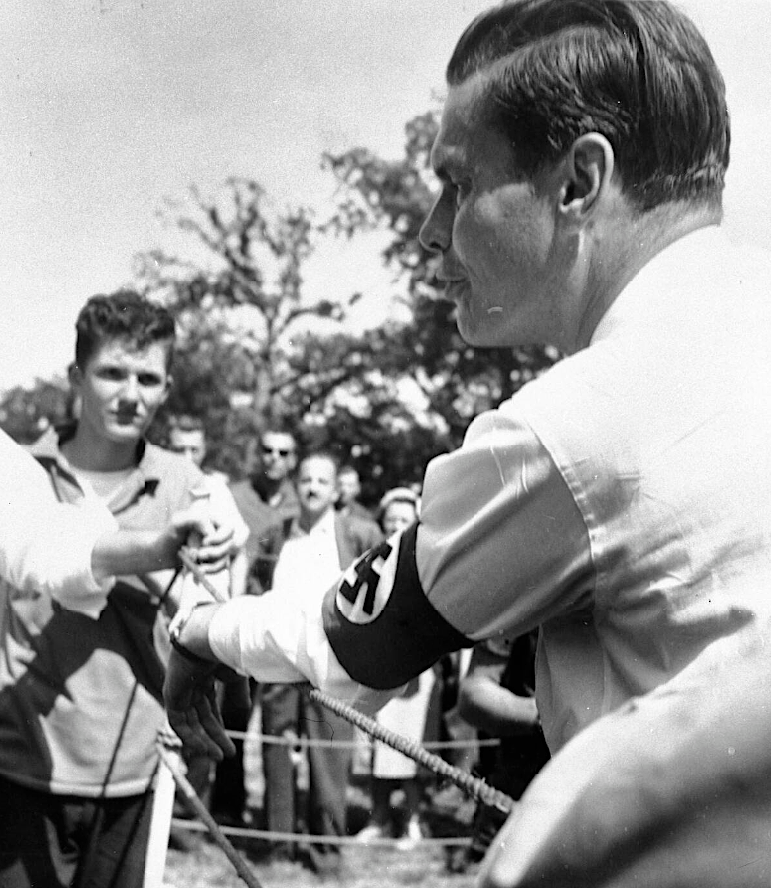
George Lincoln Rockwell, wearing a swastika
Source: Fotocollectie Anefo (Netherlands), Nazi-leider Lincoln Rockwell doodgeschoten
In 2021, the National Park Service searched for a new gravesite in Fredericksburg National Cemetery. The last Civil War veteran had been buried in the cemetery in 1945 and it had been declared "closed" in 2010, but new remains were discovered in 2015 at the site of a hospital during the Battle of Fredericksburg. Ground penetrating radar was used to identify a spot with no previous burial and no archeological resources.
Thousands of Union and Confederate soldiers were killed in battles around Fredericksburg between 1862-64. Many were buried without a name being marked permanently on the grave, unlike remains of soldiers who survived the war and were buried by family over the next 60 or so years. Of the 15,000 gravesites created in Fredericksburg National Cemetery for Union soldiers since 1866, 12,700 are marked "Unknown."
Research by the National Park Service and the City of Fredericksburg could not identify the personal identities of the three soldiers discovered in 2021, but did determine they were part of the Union army. The remains were reburied in Fredericksburg National Cemetery on May 2, 2025, the most recent internment of Civil War soldiers in Virginia.6
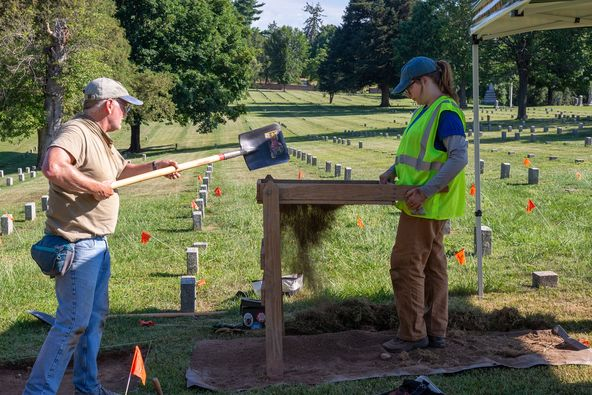
in 2021, the National Park Service searched for a site in Fredericksburg National Cemetery for burial of remains of Civil War soldiers discovered in 2015
Source: Facebook, Fredericksburg and Spotsylvania County Battlefields National Military Park (June 30, 2021)
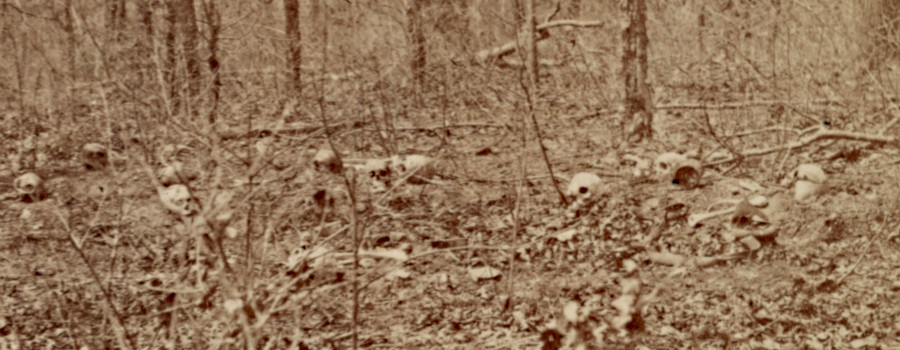
skeletons littered the ground at Chancellorsville in April 1865, two years after the battle
Source: Library of Congress, Remains of unburied soldiers, one-half mile S.W. of Chancellorsville House